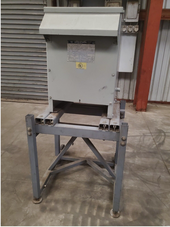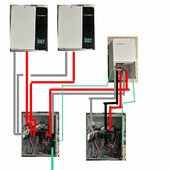No, not pointless, it would show how much is on the neutral alone, with balanced loads of 120V
He is suggesting using 12.5 to 15A breaker to feed the autotransformer, and i am asking for his data to show if loads are balanced is there any load on the neutral.
Of course that would be no current on neutral. I didn't test it, would have seen some current due to slight differences in load resistance or winding turns count.
The goal is to protect transformer while allowing user a wide range of 120V loads. They could put 4x 1500W space heaters on L1 and 4x 1500W on L2, zero current on N from auto-transformer. But as thermostats cycle, imbalance appears and transformer is overloaded.
Why is this so difficult, double pole breaker immediately after the inverter before the transformer then everything is protected. Why are y'all making this so complicated.
12kW of inverters, 3kW transformer.
If you put 12.5A 2-pole breaker after inverter, user can have up to 3000W load total on any combination of 120V L1/N, 120V L2/N, 240V L1/L2. But they can't use more than 3000W, and they bought 12kW of inverters.
If you put larger than 12.5A 2-pole breaker in L1/L2 then they can have larger loads. But imbalance greater than 3000W causes transformer overheating and failure.
I think that everyone agrees with that.
The difference of opinion is regarding that breakers size.
Although some people thing 25A 2-pole breaker would protect transformer.
Without clever use or triple pole 25A L1,L2,N breakers or some electronic trip solution the only simple electro-mechanical way to ensure autotransfomer is not overloaded is 12.5A L1,L2 breaker.
Clever is what we're all about.
Another solution is to parallel 2 identical autotransformers.
Or one big honkin' autotransformer.
My 25kVA 240/480V to 120/240V transformer can carry 50A in each of two 240V primary windings.
So I connect them in series (480V configuration), apply 240V up to 50A (12.5kW), and draw up to 100A at 120V between center-tap N and either L1 or L2.
That solution is 100% rated for his 2x 6kW inverters.
Cost me somewhere between $300 and $600 used, plus a day's drive each way to San Diego and back.
No opinion required, the size of the wire determines that, as we all should know.
Although ampacity of enamel wire wrapped in a tight coil isn't immediately obvious to me.
And remember each coil has a wire pigtail on each end. Do you pull center tap "N" out as those two wires, or join together and bring out one (undersized) wire.
I just do not know why we are still talking about transformers, all this is bloody dangerous in the hands of the general public.
Because Victron did it right, then Solar Edge, Growatt, and others said, "Me too!"
 . . . Here you go, E-bay, 25KVA, tiny little thing $562.50, $2000 shipping (just kidding). Totally isolates one side from the other, just don't pull over 25KVA all together and you are good to go!
. . . Here you go, E-bay, 25KVA, tiny little thing $562.50, $2000 shipping (just kidding). Totally isolates one side from the other, just don't pull over 25KVA all together and you are good to go!







